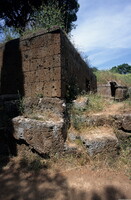Cerveteri: Etruscan Necropolises
unknown (Etruscan)

Download1A3-EA-C-H5_cp.jpg (691.2Kb)
Alternative Title
Necropoli della Banditaccia
Date
-800--300Description
View of a row tomb with a tumulus mound in the background; The Etruscan city of Caisra, usually known by its Roman name, Caere, was situated on a tufa plateau bounded by two streams, extending north-east of modern Cerveteri. The site is especially important for the extensive Etruscan necropolises on the surrounding hillsides. The ancient town itself has been only partially excavated. From ca. 700 BCE to ca. 650 BCE Cerveteri grew rapidly. From the Etruscan period are two types of tombs; tumulus or mound tombs and rectangular tombs built in long rows along 'streets'. The mounds are circular structures built in tuffa, and the interiors, carved from the living rock, house a reconstruction of the house of the dead, including a corridor (dromos), a central hall and several rooms. Modern knowledge of Etruscan daily life is largely dependent on the numerous decorative details and finds from such tombs. Source: Grove Art Online; http://www.oxfordartonline.com/ (accessed 7/16/2010)
Type of Work
necropolis (cemetery form); excavation (site)Subject
architecture, death or burial, funerary art, decorative arts, Etruscan
Rights
Rights Statement
Licensed for educational and research use by the MIT community only